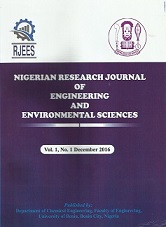Development and Optimization of Gating System Design as Applied in the Manufacture of Gasoline Generator Engine Pistons
Authors: *Aliemeke, B.N.G., Solomon, S., Udoji, C.S., Omoruyi, O.B., Obozokhae, D.O. And Osawe, C.
DOI Info: http://doi.org/10.5281/zenodo.15778288
ABSTRACT
The development and optimization of the gating system for the manufacture of gasoline generator pistons has been successfully carried out. The casting of engine components depends practically on the application of gating system that regulates the flow of molten metal into the mould cavity. Clearly, the quality and performance of the engine components depends on the mode of casting. An inadequate gating system design may result in defect such as shrinkage and porosity, which may inadvertently result in the compromise of engine component integrity and reduce component efficiency. The sandcasting designed gating system developed, had the pouring basin, sprue, runner, mould cavity, ingate and choke which accommodated and transmitted the molten aluminium alloy within the flow segment. The gating system designed for the generator engine component had a piston pattern of thickness, length and external diameter of 4.572 mm, 51.51 mm and 47.516 mm respectively. The gating system produced a 0.063 kg at a pouring time of 7.05 s with a runner size of 490 mm2. A major optimization phase comprising of Design of Experiment, Signal-to-noise ratio, ANOVA and Genetic Algorithm was conducted to decide optimal gating parameters such as pouring time, pouring temperature and runner size. Optimal levels of pouring time, pouring temperature and runner size of the gating system were determined to be 19.99 s,779.98 oC and 489.99 mm2 respectively. The optimized design showed great improvements in the piston cast quality and defect minimization.
Affiliations: *Department of Welding and Fabrication Engineering, School of Engineering, Auchi Polytechnic, Nigeria.
Keywords: Optimization, Gating System, Piston, Engine Component, Sandcasting
Published date: 2025/06/30









